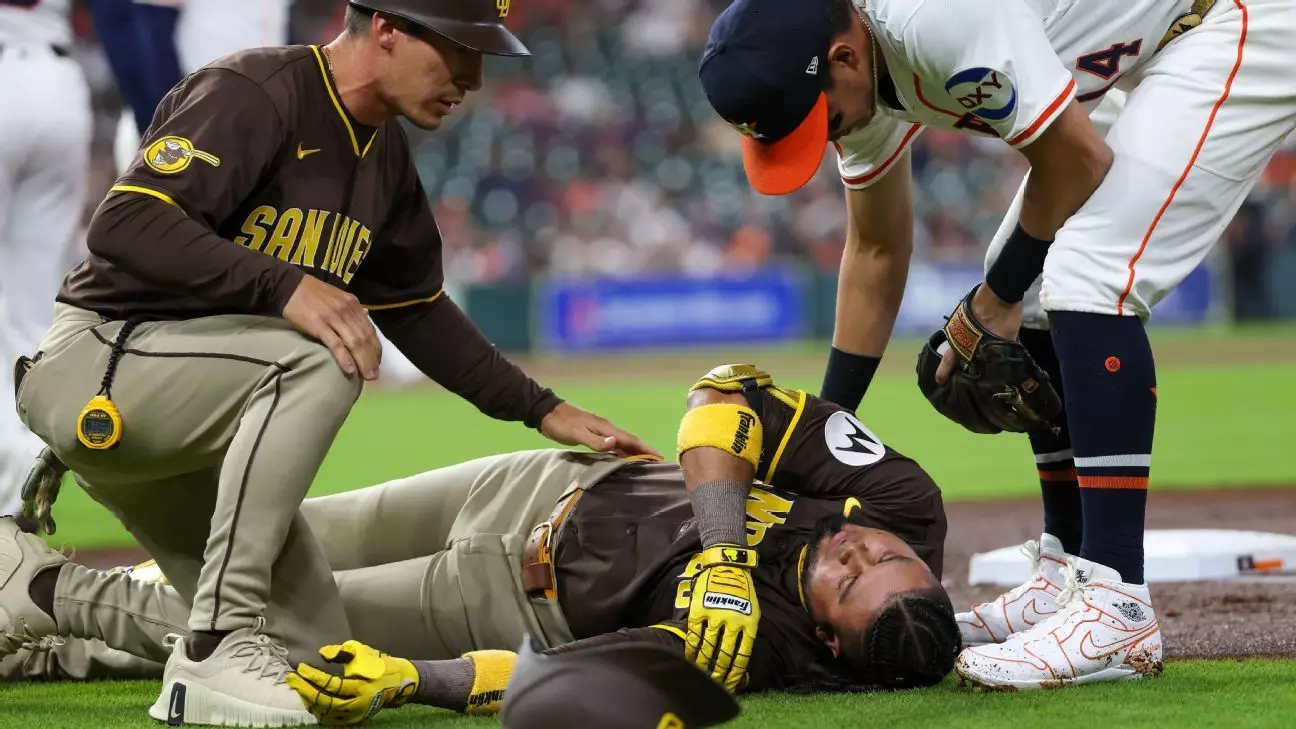Luis Arraez’s recent injury has shaken the baseball world, not merely due to the physical trauma but because it reveals the intimate intersection between sports and human vulnerability. The San Diego Padres placed Arraez on the seven-day concussion injured list following a harrowing incident during a game against the Houston Astros, where he collided with second baseman Mauricio Dubon in an unsettling moment that left fans and teammates deeply concerned. Such occurrences serve as sobering reminders of the risks athletes face while pursuing excellence in their craft.
The unsettling scene unfolded with Arraez bundling the ball towards first base, colliding with an unsuspecting Dubon. Barely moments after the incident, Arraez lay motionless, leading to immediate medical intervention. He was carted away, an image that stirs unease in any spectator. However, this incident raises important discussions about player safety, the protocols surrounding head injuries, and the responsibilities of teams to prioritize their athletes’ health.
The Reassurances After the Storm
Manager Mike Shildt’s reassuring comments following the incident provided a glimmer of hope through the anxiety. Initial tests revealed no structural damage, and although Arraez experienced soreness, the outlook was comparatively favorable. “It’s overall very favorable relative to how scary that looked,” Shildt noted. This comment emphasizes both the relief felt by the organization and the continued trepidation that accompanies injuries, particularly concussions, in high-contact sports.
Athletes are more than mere pawns in a game; they are individuals with dreams, aspirations, and loved ones. As fans and members of the sports community, we must acknowledge that their wellbeing often extends beyond the physical terrain. Shildt’s careful recounting of Arraez’s night—who returned to the ballpark after hospitalization—serves as a narrative of resilience amidst chaos. As athletes grapple with the spectrum of injuries that can derail their careers, it is essential to remember their humanity.
Signs of Sportsmanship and Unity
What emerges from this unfortunate incident is not merely the physical peril faced by Arraez but also the unity and sportsmanship shown by players across teams. Dubon, visibly shaken by the collision, expressed heartfelt concern for Arraez, recognizing that in that moment, competitor identities faded, and humanity took precedence. “It was scary,” Dubon confessed, reflecting the shared emotional burden athletes experience, even in the heat of competition.
Likewise, stars like Fernando Tatis Jr. and Manny Machado felt an immediate responsibility to support Arraez. Their actions—praying for him, showing genuine concern—illustrate the camaraderie that transcends rivalry. Such unity highlights a vital aspect of sports culture: mutual respect and care, reminding us that at times, the game is bigger than the scoreboard.
The Road Ahead: Caution Is Key
As Arraez undergoes concussion protocol, with more tests scheduled to assess his cognitive health, one wonders how sports organizations can bolster safety measures. The pall of long-term concussion effects looms large over sports, making it imperative that teams expand understanding of injuries and take a proactive stance in educating players and coaching staff on the potential impacts.
The involvement of medical staff on-site, the application of swift follow-up protocols, and the mental health aspects of recovery are crucial. As Shildt indicated, Arraez’s case could turn out more favorable than many expected, but this incident should serve as a pivotal moment for discussions on player welfare. Will other organizations take heed? Will the sport proactively adapt to protect its players, or will it remain reactive? The ball is in their court.
A Celebration of the Athlete’s Spirit
As sports enthusiasts, we often idolize players for their statistics, skills, and accolades while inadvertently overlooking their very human experiences. Luis Arraez, with his impressive track record—three consecutive batting titles and a powerful presence on the field—is not defined solely by his athletic feats. He embodies the spirit of tenacity, strength, and resilience, qualities that resonate in moments of adversity.
In today’s contemporary sports landscape, where every player is scrutinized under a microscope, the celebration of Arraez’s return to the field holds compelling narratives for fans and aspiring athletes alike. As he recovers, it becomes clear that while statistics matter, the heart and soul—the indomitable spirit of the player—are what truly inspire and remind us of the beauty and fragility of life in sports.


Leave a Reply